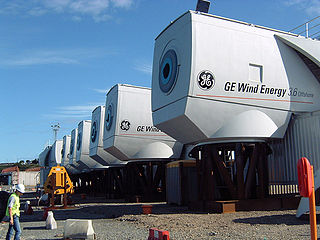
SSE Airtricity is an energy company founded in Ireland in 1997, and now a subsidiary SSE plc. SSE Airtricity supplies and distributes electricity and gas to Northern Ireland and the Republic of Ireland.

The United Kingdom is the best location for wind power in Europe and one of the best in the world. By 2023, the UK had over 11 thousand wind turbines with a total installed capacity of 28 gigawatts (GW): 14 GW onshore and 14 GW offshore, the sixth largest capacity of any country. Wind power is the largest source of renewable energy in the UK, but at under 5% still far less primary energy than oil or fossil gas. Wind generates more than a quarter of UK electricity, but less than gas over a whole year.
Finavera Wind Energy Inc. is a former Canadian wind power company, between 2007 and 2017, that owned and operated wind farms in northeastern British Columbia. Headquartered in Vancouver, the company began listing shares on TSX Venture Exchange in 2007 until it was acquired in 2017 by Solar Alliance Energy Inc TSX: SOLR. Formerly named Finavera Renewables Inc., the company develops wind farms in Canada and Ireland. The company was founded in Dublin, Ireland, in 2003. On 4 April 4, 2005, Finavera acquired a 10% stake in the wave energy technology company AquaEnergy Group, and in 2006, it acquired rest of the shares in AquaEnergy. AquaEnergy became a wholly owned subsidiary of Finavera and was renamed Finavera Renewables Ocean Energy. It developed the AquaBuOY wave energy conversion technology with plan to install the converter in Makah Bay off the coast of Newport, Oregon. However, in 2010 Finavera Renewables Ocean Energy was sold and Finavera concentrated to the wind energy.

SSE plc is a multinational energy company headquartered in Perth, Scotland. It is listed on the London Stock Exchange, and is a constituent of the FTSE 100 Index. SSE operates in the United Kingdom and Ireland.

Arklow Bank Wind Park is a 25 megawatt offshore wind farm generating electrical power for the Wicklow region in Ireland. It is the first offshore wind farm in Ireland, and the world's first erection of wind turbines rated over 3 MW. It is located on the Arklow Bank, a shallow water sandbank in the Irish Sea, around 10 kilometers (6.2 mi) off the coast of Arklow with an area of 27 by 2.5 kilometres.

The production of renewable energy in Scotland is a topic that came to the fore in technical, economic, and political terms during the opening years of the 21st century. The natural resource base for renewable energy is high by European, and even global standards, with the most important potential sources being wind, wave, and tide. Renewables generate almost all of Scotland's electricity, mostly from the country's wind power.

Greater Gabbard is a 504 MW wind farm, built on sandbanks 23 kilometres (14 mi) off the coast of Suffolk in England at a cost of £1.5 billion. It was completed on 7 September 2012 with all of the Siemens SWT3.6–107 turbines connected. Developed as a joint venture between Airtricity and Fluor, it is now jointly owned by SSE Renewables and Innogy.

Wind power is the fastest-growing renewable energy technology in Scotland, with 11,482 megawatts (MW) of installed wind power capacity by Q1 2023. This included 9,316 MW from onshore wind in Scotland and 2,166 MW of offshore wind generators.

Meentycat wind farm is a wind farm located north of Ballybofey, County Donegal, Ireland. Erected in 2004, it was Ireland's largest wind farm when it opened in 2005. Originally owned by Airtricity, as of 2020 it was run by SSE Renewables.
As of 2021 The island of Ireland has 5,585 megawatt and the Republic of Ireland has 4,309 MW of installed wind power nameplate capacity, the third highest per capita in the world. In 2020 wind turbines generated 36.3% of Ireland's electrical demand, one of the highest wind power penetrations in the world.

Keadby Power Stations are a pair of natural gas-fired power stations near Scunthorpe in North Lincolnshire, built on the site of an older coal power station. The site lies near the B1392 and the River Trent, and the Scunthorpe-Grimsby railway. Also nearby is the Stainforth and Keadby Canal, which is part of the Sheffield and South Yorkshire Navigation. The current stations are operated by SSE Thermal.

Hydroelectric power in New Zealand has been a part of the country's energy system for over 100 years and continues to provide more than half of the country's electricity needs. Hydroelectricity is the primary source of renewable energy in New Zealand. Power is generated the most in the South Island and is used most in the North Island.
The electricity sectors of the Republic of Ireland and Northern Ireland are integrated and supply 2.5 million customers from a combination of coal, peat, natural gas, wind and hydropower. In 2022, 34 TWh were generated. In 2018 natural gas produced 51.8%, while wind turbines generated 28.1%, coal 7%, and peat 6.8% of Ireland's average electricity demand. In 2020 wind turbines generated 36.3% of Ireland's electrical demand, one of the highest wind power proportions in the world. While the United Kingdom was one of the first countries in the world to deploy commercial nuclear power plants, the island of Ireland has never had a nuclear power plant built on either side of the Irish border. Nuclear power in Ireland was discussed in the 1960s and 1970s but ultimately never phased in, with legislation now in place explicitly forbidding its introduction.

Policy makers often debate the constraints and opportunities of renewable energy.

Renewable energy in Russia mainly consists of hydroelectric energy. In 2010, the country was the sixth largest producer of renewable energy in the world, although it was 56th when hydroelectric energy was not taken into account. Some 179 TWh of Russia's energy production came from renewable energy sources, out of a total economically feasible potential of 1823 TWh. 16% of Russia's electricity was generated from hydropower, and less than 1% was generated from all other renewable energy sources combined. Roughly 68% of Russia's electricity was generated from thermal power and 16% from nuclear power.

As of 2018, hydroelectric power stations in the United Kingdom accounted for 1.87 GW of installed electrical generating capacity, being 2.2% of the UK's total generating capacity and 4.2% of UK's renewable energy generating capacity. This includes four conventional hydroelectric power stations and run-of-river schemes for which annual electricity production is approximately 5,000 GWh, being about 1.3% of the UK's total electricity production. There are also four pumped-storage hydroelectric power stations providing a further 2.8 GW of installed electrical generating capacity, and contributing up to 4,075 GWh of peak demand electricity annually.
Shetland HVDC Connection is a high-voltage direct current submarine power cable under construction to connect Shetland to the British mainland.
Scottish and Southern Electricity Networks is one of two energy companies in the UK to be involved both in electricity transmission and distribution.













